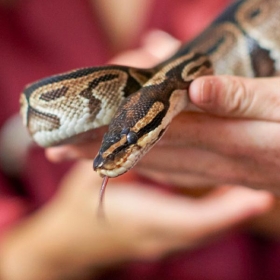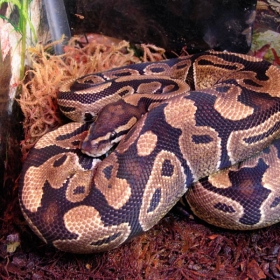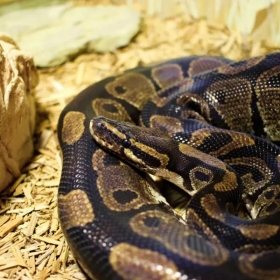
Royal Python
Python regius
Animal Behavior: Ball pythons move by way of rectilinear locomotion, whereby bilateral symmetrical contractions propel them forward as they push against the surface. Ball pythons are known for the protective mechanism of "balling", where they form a tight ball with the head at the center in response to threats, earning them their common name, "ball python."
Eating Habits: Ball pythons are carnivorous and have mobile lower and upper jaws. They use chemical and visual cues to hunt for their prey. Ball pythons sit and wait to ambush prey. As heavy-bodied snakes, they are less active and instead choose good ambush sites. The feeding strategy is to retract the head and neck and strike rapidly. After the rapid strike, they swallow prey alive or immobilize by constriction. They feed almost exclusively on rodents and eat infrequently.
Range: Ball pythons (Python regius), also known as royal pythons, are found in the grasslands and open forests of West and Central Africa.
Conservation Efforts: Because of their large range and high, stable population numbers, ball pythons are not considered threatened currently. A change to highly mechanized farming and substantial use of agrochemicals may change survival rates of ball pythons, affecting populations.
Animal Facts: Vision plays an important role in a ball python's ability to secure prey. Research on the way these snakes behaved under bright light determined that ultraviolet activity may be a factor in capturing prey. Other research suggests that ball pythons may follow the scent trails of their mammalian prey because those trails reflect ultraviolet light.


